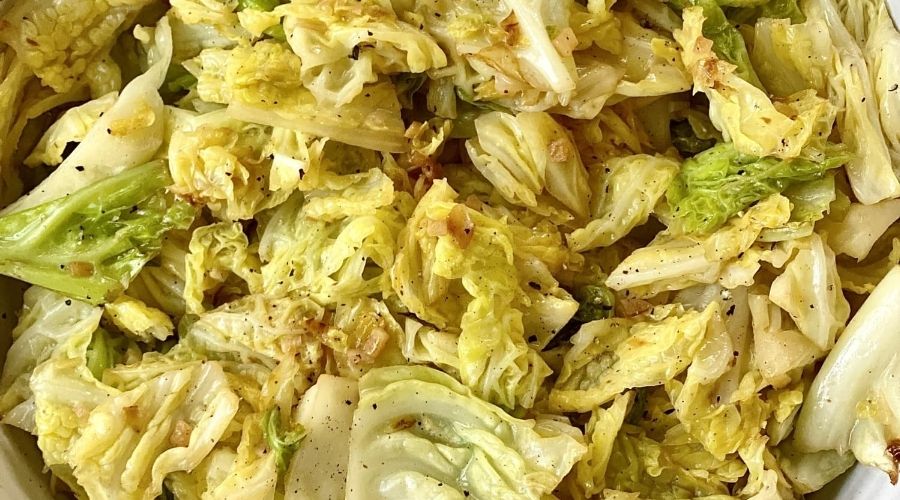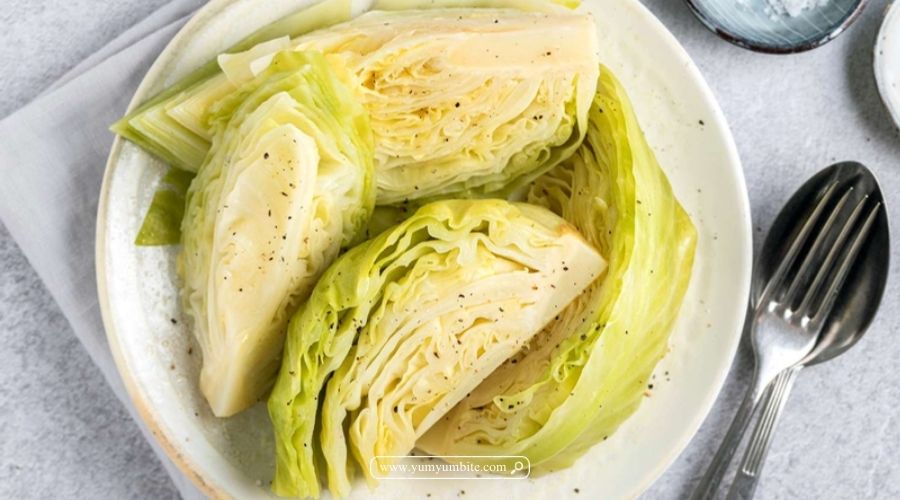Storing cooked cabbage properly is essential for maintaining its flavor, texture, and nutritional value.
Whether you’ve prepared a hearty cabbage dish or have leftovers from a family meal, knowing how to store cooked cabbage can help you minimize waste and enjoy its deliciousness later.
In this guide, we’ll explore the best practices for storing cooked cabbage, including tips on container selection, cooling techniques, and how to identify spoilage.
With the right storage methods, you can keep your cooked cabbage fresh and ready for your next culinary adventure.
Why Storing Cooked Cabbage Properly Matters
Storing cooked cabbage properly is crucial for maintaining its taste, texture, and nutritional value.
Cabbage is a versatile vegetable that can be used in a variety of dishes, from stir-fries to salads, and it’s packed with vitamins and minerals. When cooked, however, cabbage can spoil quickly if not stored correctly.
Proper storage helps prevent the growth of harmful bacteria, which can lead to foodborne illnesses. Additionally, it minimizes food waste, allowing you to enjoy leftovers without compromising quality.
By keeping cooked cabbage in airtight containers and ensuring it’s stored at the right temperature, you can extend its shelf life and preserve its delicious flavor, making it a healthy and convenient option for your meals.
Understanding the importance of proper storage not only enhances your culinary experience but also supports a more sustainable kitchen.
How to Store Cooked Cabbage: A Complete Guide

Storing cooked cabbage correctly ensures its freshness and safety, allowing you to enjoy this nutritious vegetable in your meals for days.
Here’s a comprehensive guide on how to effectively store cooked cabbage.
1. Cool Down Properly
Before storing, let the cooked cabbage cool to room temperature. This typically takes about 30 minutes.
Cooling it properly is essential to prevent condensation inside the storage container, which can promote bacterial growth.
2. Choose the Right Container
Use airtight containers made of glass or BPA-free plastic for storing cooked cabbage. Ensure the container has a secure lid to keep out air and moisture.
If you don’t have a container, resealable plastic bags can also work, but be sure to remove as much air as possible before sealing.
3. Portion Control
Consider dividing the cooked cabbage into smaller portions, especially if you don’t plan to eat it all at once.
This makes it easier to reheat only what you need, minimizing waste and ensuring even heating.
4. Label and Date
Always label your storage containers with the date the cabbage was cooked.
This practice helps you keep track of how long it has been stored and ensures you consume it within a safe timeframe.
5. Refrigeration
Store the cooked cabbage in the refrigerator if you plan to eat it within a few days. It’s best consumed within 3 to 5 days for optimal taste and safety.
Ensure your refrigerator is set to a temperature of 40°F (4°C) or below.
6. Freezing for Long-Term Storage
If you want to store cooked cabbage for a longer period, consider freezing it. Place the cooled cabbage in freezer-safe containers or bags, ensuring to remove excess air.
Frozen cooked cabbage can last up to 10 to 12 months. When you’re ready to use it, thaw it in the refrigerator overnight before reheating.
7. Reheating
When reheating stored cooked cabbage, ensure it reaches an internal temperature of 165°F (74°C) to kill any potential bacteria.
You can reheat it in the microwave, on the stovetop, or in the oven.
8. Check for Signs of Spoilage
Before consuming stored cooked cabbage, inspect it for signs of spoilage, such as off odors, discoloration, or a slimy texture.
If any of these signs are present, it’s safer to discard the cabbage.
By following these steps, you can effectively store cooked cabbage, preserving its flavor and nutritional benefits while ensuring your meals remain safe and enjoyable.
What to Look for While Storing Cooked Cabbage

When storing cooked cabbage, paying attention to specific factors can help ensure its freshness and safety.
Here’s what to look for to maintain the quality of your cooked cabbage:
1. Cooling Temperature
Before storing, make sure the cooked cabbage has cooled to room temperature.
Avoid placing hot cabbage directly into the refrigerator, as this can raise the internal temperature and affect other stored foods.
2. Container Type
Choose airtight containers made from glass or BPA-free plastic. Ensure the containers are clean and dry before adding the cabbage.
This prevents contamination and helps maintain freshness.
3. Portion Sizes
Consider the portion sizes of cooked cabbage you’re storing.
Smaller portions are easier to reheat and reduce waste, as you only take out what you need.
4. Labeling
Label the containers with the date of cooking.
This helps you keep track of how long the cabbage has been stored and ensures you use it within the safe timeframe.
5. Refrigerator Temperature
Ensure your refrigerator is set to 40°F (4°C) or below. This temperature helps slow down bacterial growth, keeping your cooked cabbage safe to eat.
6. Signs of Spoilage
Always check for signs of spoilage before consuming stored cooked cabbage.
Look for off odors, discoloration, or a slimy texture, which can indicate that the cabbage has gone bad.
7. Freezing Considerations
If freezing, ensure the cooked cabbage is placed in freezer-safe containers or bags with as much air removed as possible.
This prevents freezer burn and helps preserve flavor.
By keeping these factors in mind while storing cooked cabbage, you can enjoy its delicious taste and nutritional benefits while minimizing the risk of spoilage.
How to Choose the Right Accessories for Storing Cooked Cabbage

Selecting the right accessories for storing cooked cabbage is essential for maintaining its freshness and quality.
Here are some key considerations to help you make the best choices:
1. Airtight Containers
Opt for airtight containers that seal securely. Glass containers are excellent because they don’t retain odors and are microwave-safe, making reheating convenient.
BPA-free plastic containers are also a good choice, especially for easy stacking in the refrigerator or freezer.
2. Portion Control
Consider using smaller containers for portion control.
This allows you to store cooked cabbage in individual servings, making it easier to reheat just what you need without exposing the entire batch to air, which can cause spoilage.
3. Freezer Bags
If you plan to freeze cooked cabbage, look for heavy-duty freezer bags.
These bags help prevent freezer burn when sealed tightly and can be laid flat for efficient storage in the freezer. Make sure to remove as much air as possible before sealing.
4. Labels and Markers
Invest in labels and a permanent marker or masking tape.
Labeling your containers with the date of cooking helps you keep track of freshness and ensures that you consume the cabbage within a safe timeframe.
5. Foil or Plastic Wrap
For short-term storage, you can use aluminum foil or plastic wrap to cover dishes of cooked cabbage.
Ensure the cover is tight to minimize air exposure, but for longer storage, it’s best to transfer the cabbage to a sealed container.
6. Vacuum Sealers
For long-term storage, consider using a vacuum sealer.
This device removes air from bags and seals them tightly, extending the shelf life of cooked cabbage significantly by preventing freezer burn and oxidation.
7. Proper Utensils
When handling cooked cabbage for storage, use clean utensils to avoid contamination.
Avoid using the same utensils that were in contact with raw foods, as this can introduce harmful bacteria.
By choosing the right accessories, you can effectively store cooked cabbage, ensuring it stays fresh, safe, and ready to enhance your meals whenever you need it.
How to Tell If Cooked Cabbage Is Bad After Storing
Determining whether cooked cabbage has gone bad is crucial for food safety and preventing foodborne illnesses.
Here are the key indicators to look for when assessing the quality of stored cooked cabbage:
1. Off Odors
One of the first signs that cooked cabbage has spoiled is a strong, unpleasant odor. Fresh cooked cabbage has a mild, slightly sweet scent.
If you detect a sour or rancid smell, it’s a clear indication that the cabbage is no longer safe to eat.
2. Color Changes
Examine the color of the cooked cabbage. Fresh cooked cabbage should maintain its vibrant green or pale color, depending on the variety.
If you notice any browning, yellowing, or significant discoloration, it may indicate spoilage.
3. Texture Alterations
Fresh cooked cabbage should be tender yet slightly crisp.
If the texture appears slimy or mushy, this is a sign that the cabbage has deteriorated and should be discarded. A slimy coating can also indicate bacterial growth.
4. Mold Growth
Check for any signs of mold on the surface of the cooked cabbage.
Mold can appear as fuzzy spots in various colors (green, black, white) and is a definitive sign that the cabbage is no longer safe to consume.
If you see any mold, throw the cabbage away immediately.
5. Taste Test
If the cooked cabbage looks and smells acceptable but you’re still unsure, you can perform a small taste test.
If it tastes off or has an unusual flavor, it’s best to err on the side of caution and discard it.
6. Storage Duration
Consider how long the cooked cabbage has been stored.
Generally, cooked cabbage should be consumed within 3 to 5 days when stored in the refrigerator.
If it has been longer than this, it’s safer to throw it away, even if there are no visible signs of spoilage.
By keeping an eye on these indicators, you can ensure that you enjoy safe and delicious meals while minimizing the risk of consuming spoiled cooked cabbage.
1. How long can I store cooked cabbage in the refrigerator?
Cooked cabbage can be stored in the refrigerator for 3 to 5 days. Make sure to keep it in an airtight container to maintain freshness.
2. Can I freeze cooked cabbage?
Yes, you can freeze cooked cabbage. Place it in freezer-safe containers or heavy-duty freezer bags, ensuring to remove as much air as possible.
Frozen cooked cabbage can last for 10 to 12 months.
3. How should I cool cooked cabbage before storing it?
Allow the cooked cabbage to cool to room temperature before storing it.
This helps prevent condensation inside the storage container, which can lead to spoilage.
4. What type of container is best for storing cooked cabbage?
Airtight containers made of glass or BPA-free plastic are ideal for storing cooked cabbage.
They help prevent air and moisture from affecting the cabbage’s freshness.
5. How can I tell if stored cooked cabbage has gone bad?
Check for off odors, color changes, slimy texture, mold growth, or an unusual taste.
If any of these signs are present, it’s best to discard the cabbage.
6. Should I portion cooked cabbage before storing it?
Yes, portioning cooked cabbage into smaller containers is a good idea.
This allows you to reheat only what you need, minimizing waste and ensuring better quality.
7. Can I reheat cooked cabbage after storing it?
Absolutely! Just make sure to reheat it to an internal temperature of 165°F (74°C) to ensure it is safe to eat.
You can reheat cooked cabbage in the microwave, on the stovetop, or in the oven.
Conclusion
In conclusion, mastering the art of storing cooked cabbage is a simple yet vital skill for any home cook.
By following the guidelines outlined in this article, you can ensure that your cooked cabbage remains safe to eat and retains its delightful taste and texture.
From choosing the right containers to recognizing signs of spoilage, taking these steps will allow you to enjoy your cabbage dishes without worry.
So go ahead and store those leftovers with confidence, knowing you’re making the most of your ingredients!
References
- https://www.wellplated.com/sauteed-cabbage/
- https://www.allrecipes.com/recipe/73833/southern-fried-cabbage/
- https://divascancook.com/southern-cabbage-recipe/
- https://www.budgetbytes.com/fried-cabbage/
- https://www.thespruceeats.com/how-to-cook-boiled-cabbage-3052247


